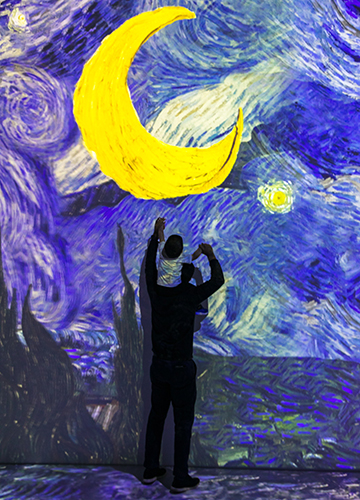In the winter of 1884-85, Dutch artist Vincent van Gogh painted his first multi-figured, large-scale composition―’The Potato Eaters’―depicting the harsh reality of country life by capturing a peasant family sharing a meal. Van Gogh said he wanted to portray peasants who “have tilled the earth themselves, with the same hands they are putting in the dish... that they have thus honestly earned their food”. At the time, the painting was criticised for its coarse style and the darkness of the figures. Since then, it has become one of his most famous works. Now, an exhibition―the Van Gogh 360° Immersive Art Experience―aims to animate the five peasants in the painting. They lift their mugs and nod at you―as though silently agreeing with something you just said. From a viewer, you have become a guest in his painting.
The exhibition debuted at the World Trade Centre in Mumbai earlier this year and now travels to Delhi from April 14 to May 31. To see a painting is one thing; to live inside it is quite another. And that is what Van Gogh 360° strives to do―to give you a joyride inside the fantasy land that was the Dutch artist’s mind. So, his sunflowers and almond blossoms sway to the wind’s rhythm, the stars from his ‘Starry Night’ twinkle merrily, crows flap their wings, and leaves float to the ground. The extensive projections of Van Gogh’s post-impressionist works fill the walls, the ceilings and the floors. Your body, too, becomes his canvas. It is almost a psychedelic experience to look down and find butterflies perched on your arms. Moonlight from his paintings stabs you and flowers sprout on the tilled field of your skin. Ticket prices start at Rs699. Inside, you can lounge on the benches or lie on the floor to get the full Van Gogh experience. The immersion runs on a loop of 45 minutes and one can stay for as long as one likes.

Van Gogh became an artist at the age of 27. Within 10 years (1880-1890), he had produced nearly 900 paintings and 1,100 works on paper. For him, his art was a reprieve from a life weighed down by mental illness, suicidal tendencies and a feeling of worthlessness. On July 27, 1890, he shot himself in the chest. The fame he never achieved in life came calling upon his death. By the beginning of World War I, Van Gogh had come to be regarded as one of the finest artists in the history of modern art.
Festival House Inc, the Canadian events company which brought Van Gogh 360° to India, says that they got in touch with a “talented animator” who selected the paintings from his body of work and animated them to an original soundtrack. The exhibition was developed over an eight-month period. However, many who have visited similar immersive exhibitions in the US say that although the experiences are comparable, a lot is missing. “Unlike the Van Gogh 360° exhibition in the US which we visited, here there is no 3D replica of Van Gogh’s bedroom in Arles (southern France) or a colouring station for children or any virtual reality experience,” says Charu Khurana, a Mumbai-based fashion designer.
The organisers are rectifying many of the shortcomings at the Delhi show. “The Mumbai show was our first,” they told THE WEEK. “The Delhi edition will include a lounge space, a bar sponsored by Absolut Glassware, and an area for children’s creative expression.” Earlier, Van Gogh 360° India’s spokesperson, Nikhil Chinapa, had shared that the event had received a warm welcome and that the “level of interest from schools, as well as young content creators, shows that immersive art is an excellent platform to introduce global art to the younger generation.” On display are some of the artist’s greatest works―including ‘The Starry Night’, the ‘Sunflower’ series, ‘Almond Blossom’, and ‘The Night Cafe’.
The exhibition begins with an introduction about the life and times of the post- impressionist painter. It covers his deteriorating mental health, his letters to his brother, the urge to paint as a form of escapism and his eventual suicide in the wheat fields where he would otherwise sit and paint. It describes him as a lonesome figure who did not set out to paint, but almost stumbled into it. Destiny, in the end, was too potent a power to resist.
While there was enough focus on the artist, what was missing in Van Gogh 360° was a deep-dive into his art. One does get an idea about his personal anguish and the social tensions that influenced his work, but one does not get to enjoy the nuances of his style and technique. However, the organisers say that the exhibition is only meant to introduce you to Van Gogh’s work, not to cultivate an appreciation of its finer points, which is the work of museums. “The vibrancy and details of Van Gogh’s artwork are powerful and can be effectively portrayed in an immersive environment. At a museum, it may be possible to delve deeper into the art side of things, whereas immersive art exhibitions like Van Gogh 360° are about democratising art and making it more accessible for the layman,” they say.
Yet, the debate continues whether an artist of Van Gogh’s brilliance requires an “immersive experience”. But there is no denying that it is always enjoyable to witness genius in a transactional way, and to find oneself entangled in his world. To see the mist blur the margins of his mountains. To smell the aroma of cypress and cedar in his orchards. To inhabit the sunlit corners of his imagination.


